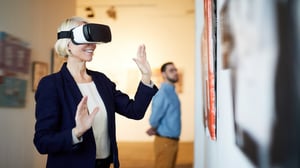Art that encourages participation has an extraordinarily beneficial power. Observing of works of art through virtual reality (VR) systems has led to improved motor skills in stroke patients.
A study as part of the discussion on art as a tool to improve rehabilitation therapy has recently been the focus of attention. It was carried by Prof. Marco Iosa and a team of researchers from the Department of Psychology, Mechanical and Aerospace Engineering at the Sapienza University and the Santa Lucia IRCCS Foundation, in partnership with Unitelma Sapienza.
The research, published in the journal Frontiers in Psychology, looked at the effect of stroke survivors interacting with famous works of art from the past reproduced through virtual reality (VR). The impact of the experiment was assessed in terms of improved motor co-ordination in patients with central nervous system injuries, more precise movements, (even in subjects with hemiplegia due to acute neurological damage) and a reduced sense of tiredness when performing tasks.
An art-based approach
The experiment was based on reflections and studies on the golden ratio and harmony in kinetics and movement, with the researchers being aware that active participation, involvement and motivation of patients undergoing rehabilitation (who are often subject to depression) is vital.
This led Prof. Iosa and his group to develop an art-based approach, with special reference to studies on mirror mechanisms in the enjoyment of aesthetics (mirror neurons) carried out by Prof. Vittorio Gallese and the research group at the University of Parma.
The responses of motor neurons stimulated by art are even more important in rehabilitation processes.
These can be direct, in the case of representation of a human figure, which creates motor and empathic responses, or they can be mechanisms of imagination and simulation of movement by the viewer in paintings such as landscapes, including abstract compositions, in which the mind simulates the gesture of creating art. This is because a therapist has to enable all possible channels in order to stimulate movement in an affected limb.
The team at the Sapienza therefore involved Dr Gaetano Tieri, a psychologist and expert in VR programming (from Santa Lucia IRCCS, Unitelma Sapienza), to create a virtual interaction system. The patient has a helmet and uses a joystick to activate a cursor. They enter a large, well-lit room with a large canvas in the centre. By moving the joystick as if it were a paintbrush, the patient interacts with a sensitive surface on which a work of art created by great masters, from Michelangelo to Renoir or Van Gogh appears.
Every trial involves the complete discovery and co-creation of a masterpiece, which is an important aid in motivating patients and encouraging them to participate. In terms of motor skills, researchers saw fewer errors, greater control of movement, quicker recovery and a reduced sense of fatigue when performing the activity where important works of art were present, compared to results from a control group who performed the same exercise by simply colouring a blank canvas.
The Michelangelo Effect
Researchers chose the name “The Michelangelo Effect” both in reference to the well-known "Mozart Effect", identified in 1993 by F. H. Rauscher and G. L. Show, which detected cognitive responses to the KV 448 Sonata, and because the virtual reconstruction of the Creation of Adam in Buonarroti's Sistine Chapel was the work that stimulated mirror neurons in the most significant way during the experiments.
There is also a great deal of interest in this study because Prof. Iosa's laboratory is located in the Santa Lucia Foundation hospital in Rome and experiments that began here have been rapidly extended to other clinical facilities.
The Nomentana Hospital in particular has also adopted the VR approach in clinical practice for patients.
This kind of cognitive neuroscience-based approach in clinical rehabilitation has a high level of potential, which also extends to the arts and communication spheres - just think of the potential implications when it is combined with museum tours or virtual tours.
By Catterina Seia e Sara Uboldi
Sara Uboldi is a PhD in Humanities, University of Modena and Reggio Emilia

